CLIMATE CHANGE VS POLAR BEARS
Posted on: July 21, 2020

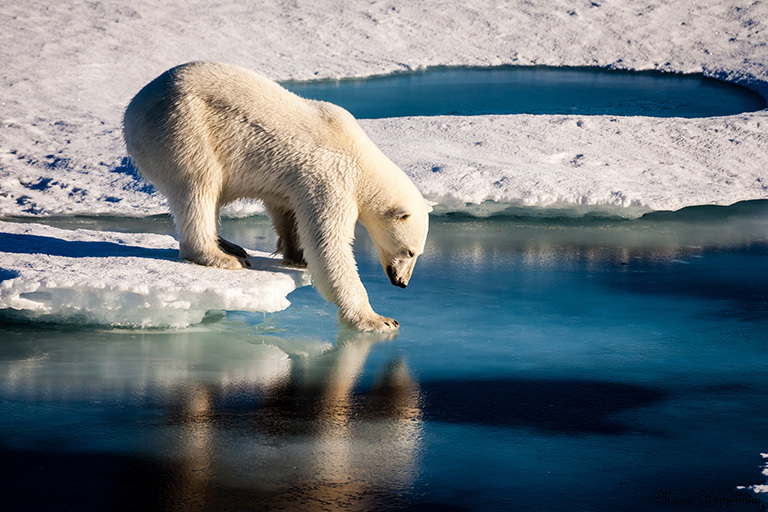
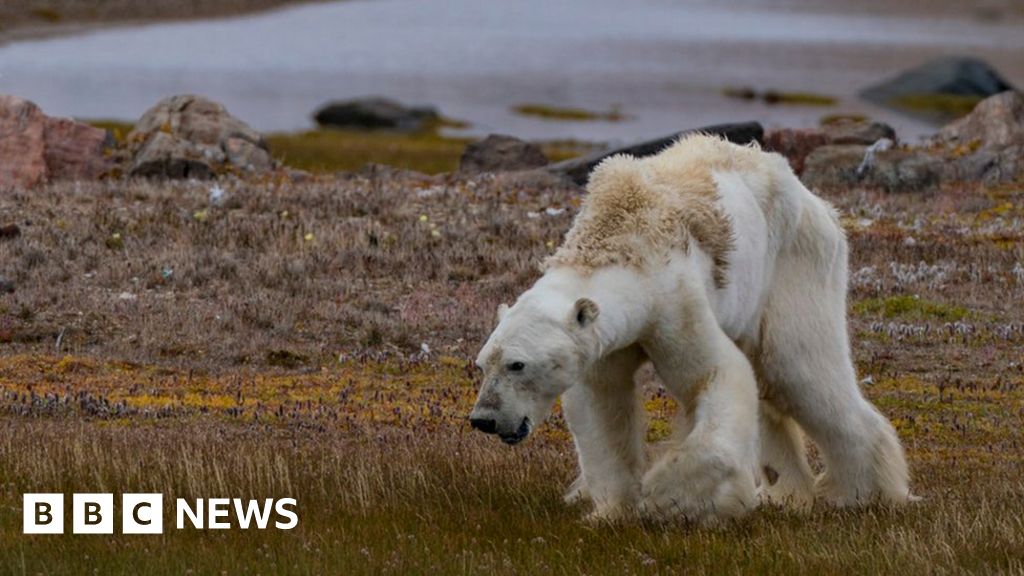
THIS POST IS A CRITICAL REVIEW OF CLIMATE SCIENCE RESEARCH FINDINGS AND MEDIA STORIES THAT CLIMATE CHANGE WILL WIPE OUT POLAR BEARS BY 2100. (with 9/25/2020 update below)
PART-1: THE RESEARCH FINDINGS
- CITATION: Molnár, P.K., Bitz, C.M., Holland, M.M. et al. Fasting season length sets temporal limits for global polar bear persistence. Nat. Clim. Chang. (2020). https://doi.org/10.1038/s41558-020-0818-9
- ABSTRACT:
- Polar bears require sea ice for capturing seals and are expected to decline range-wide as global warming and sea-ice loss continue. Estimating when different sub-populations will likely begin to decline has not been possible to date because data linking ice availability to demographic performance are unavailable for most sub-populations and unobtainable a priori for the projected but yet-to-be-observed low ice extremes.
- Here, we establish the likely nature, timing and order of future demographic impacts by estimating the threshold numbers of days that polar bears can fast before cub recruitment and/or adult survival are impacted and decline rapidly.
- Intersecting these fasting impact thresholds with projected numbers of ice-free days, estimated from a large ensemble of an Earth system model, reveals when demographic impacts will likely occur in different subpopulations across the Arctic. Our model captures demographic trends observed during 1979–2016, showing that recruitment and survival impact thresholds may already have been exceeded in some subpopulations.
- It also suggests that, with high greenhouse gas emissions, steeply declining reproduction and survival will jeopardize the persistence of all but a few high-Arctic subpopulations by 2100. Moderate emissions mitigation prolongs persistence but is unlikely to prevent some subpopulation extirpations within this century.
PART-2: THE MEDIA STORY
- Polar bears will be wiped out by the end of the century unless more is done to tackle climate change. Scientists say some populations have already reached their survival limits as the Arctic sea ice shrinks. The carnivores rely on the sea ice of the Arctic Ocean to hunt for seals. As sea ice extent declines, the animals are forced to roam for long distances and struggle to find food and feed their cubs.
- Polar bears are already sitting at the top of the world; if the ice goes, they have no place to go. Polar bears are listed as vulnerable to extinction by the International Union for Conservation of Nature (IUCN), with climate change a key factor in their decline. Female polar bears need to store sufficient fat to feed their cubs. Studies show that declining sea ice is likely to decrease polar bear numbers, perhaps substantially.
- The new study, published in Nature Climate Change, puts a timeline on when that might happen to the year 2100 because the Polar bears are running out of food as sea ice declines. By modelling the energy use of polar bears, the researchers were able to calculate their endurance limits.
- Dr Steven Amstrup, chief scientist of Polar Bears International, who was also involved in the study, told BBC News: “What we’ve shown is that, first, we’ll lose the survival of cubs, so cubs will be born but the females won’t have enough body fat to produce milk to bring them along through the ice-free season. We can only go without food for so long, that’s a biological reality for all species.
- Polar bears rely on sea ice to catch their prey. The researchers were also able to predict when these thresholds will be reached in different parts of the Arctic. This may have already happened in some areas where polar bears live. Showing how imminent the threat is for different polar bear populations is another reminder that we must act now to head off the worst of future problems faced by us all.
- The trajectory we’re on now is not a good one, but if society gets its act together, we have time to save polar bears. And if we do, we will benefit the rest of life on Earth, including ourselves. Under a high greenhouse gas emissions scenario, it’s likely that all but a few polar bear populations will collapse by 2100, the study found. Under moderate emissions reduction, several populations will disappear. The findings match previous projections that polar bears are likely to persist to 2100 only in a few populations very far north if climate change continues unabated.
- Sea ice is frozen seawater that floats on the ocean surface, forming and melting with the polar seasons. Some persists year after year in the Arctic, providing vital habitat for wildlife such as polar bears, seals, and walruses.Sea ice that stays in the Arctic for longer than a year has been declining at a rate of about 13% per decade since satellite records began in the late 1970s.
PART-3: CRITICAL COMMENTARY
- As shown in related posts, the data do show that both Arctic sea ice extent and Arctic sea ice PIOMAS volume have steadily declined in the 40-year study period 1979-2019. Links to these related posts are as follows:
- PIOMAS Arctic Sea Ice Volume: [LINK]
- Arctic Sea Ice Extent: 2018 study: [LINK]
- Arctic Sea Ice Extent: 2019 study: [LINK]
- Arctic Sea Ice Extent: Bibliography: [LINK]
- The finding in these studies shows clearly that there is a year to year decline in Arctic sea ice in the period 1979-2019. This finding is corroborated in the bibliography. However, what we also find in the bibliography is that there are significant differences in the rate of decline both regionally and in time.
- At the same time, temperature data for the Arctic region shows a steady warming rate consistent with the global warming context of the study period.
- However a correlation analysis of Arctic sea ice decline with the relevant temperature data for the region does not indicate that the observed decline is responsive to temperature at an annual time scale.
- The implication of the correlation analysis results is that though the evidence shows that temperatures are rising and that sea ice extent is falling, it does not imply that declining minimum sea ice extent in September can be attributed to rising temperatures.
- CONCLUSION: We conclude from these studies that there is no empirical evidence that global warming drives the observed decline in September minimum sea ice extent in the Arctic. Therefore, though polar bears may be threatened by the observed decline in sea ice extent, there is no evidence that the decline is caused by global warming and no evidence that the decline can be attenuated and the polar bears saved by taking climate action in the form of reducing or eliminating the use of fossil fuels.
- The observed changes in bear populations are likely a natural phenomenon and not one created by humans; and therefore not one that can be attenuated by humans. In other words, as tragic as their situation is, the observed changes are the work of nature. We are unable to save these bears.
- In fact any attempt to save them could be construed as humans interfering with nature. A contradiction in environmentalism is that it forbids humans from interfering with nature and at the same time calls on humans to interfere with nature when nature is deemed unkind by humans.
- A relevant bibliography is presented below. Although the findings do show decline in polar bear population and health during periods of sea ice decline, the literature also shows significant uncertainty in these findings and contradictions in the data that are not reflected in the media reports of these findings. The media tend to imply an extreme form of certainty in the causal connection between sea ice decline and polar bear survival. This expression of certainty is not found in the literature.
- We also find in these studies that extremely short periods of just a few years is the norm in the comparison of polar bear survival conditions in low and high sea ice extent conditions. The generalization of these short study period findings may not be possible as admitted by the authors themselves in terms of uncertainty and the use of the word “could” when making projections.
- FINALLY, THESE STUDIES SHOW A RELATIONSHIP OF POLAR BEAR POPULATION ONLY TO SEA ICE EXTENT. THE FURTHER ATTRIBUTION TO ANTHROPOGENIC GLOBAL WARMING IS ASSUMED BUT NOT SUPPORTED BY DATA. AS SHOWN IN RELATED POSTS, THERE IS NO EVIDENCE THAT SEA ICE EXTENT OR VOLUME IS RESPONSIVE TO TEMPERATURE AT AN ANNUAL TIME SCALE. {SEE PARAGRAPHS 2 TO 5 ABOVE}.
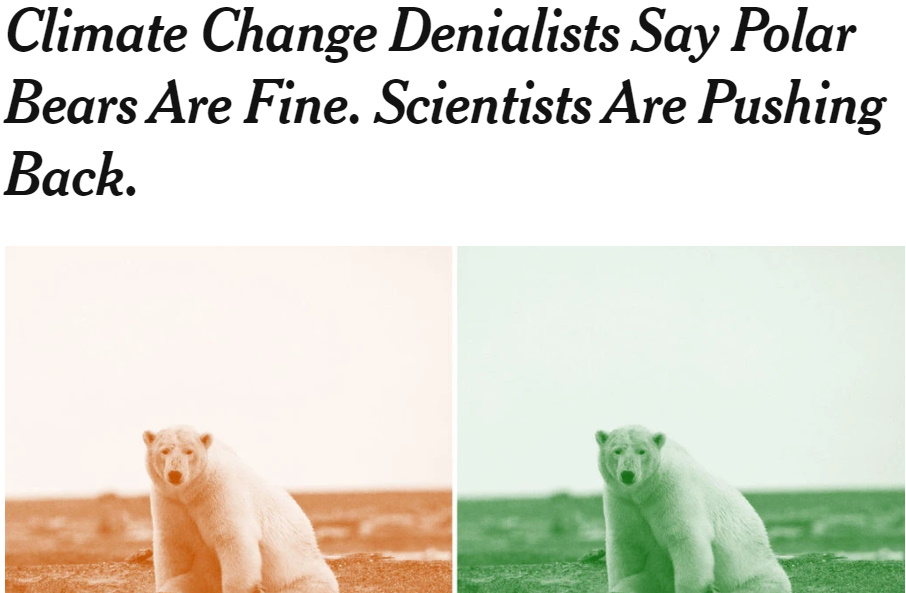
THE RELEVANT BIBLIOGRAPHY
- Stirling, Ian, and Andrew E. Derocher. “Possible impacts of climatic warming on polar bears.” Arctic (1993): 240-245.
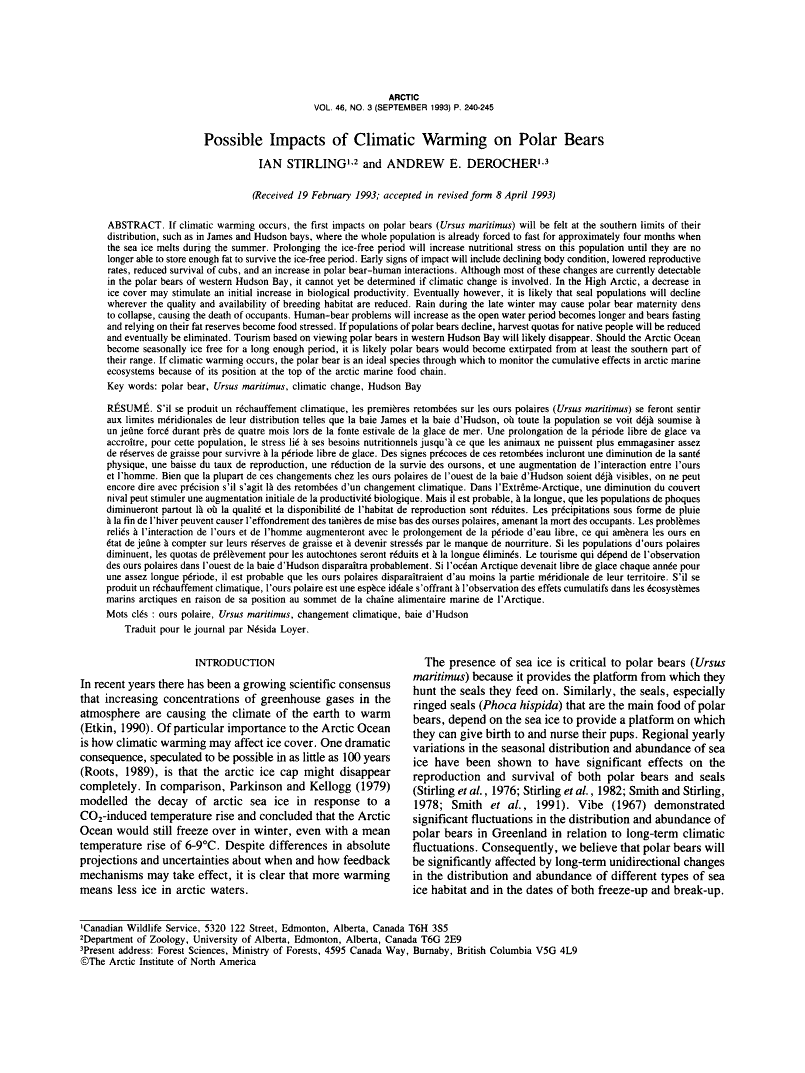
- Bromaghin, Jeffrey F., et al. “Polar bear population dynamics in the southern Beaufort Sea during a period of sea ice decline.” Ecological Applications 25.3 (2015): 634-651. In the southern Beaufort Sea of the United States and Canada, prior investigations have linked declines in summer sea ice to reduced physical condition, growth, and survival of polar bears (Ursus maritimus ). Combined with projections of population decline due to continued climate warming and the ensuing loss of sea ice habitat, those findings contributed to the 2008 decision to list the species as threatened under the U.S. Endangered Species Act. Here, we used mark–recapture models to investigate the population dynamics of polar bears in the southern Beaufort Sea from 2001 to 2010, years during which the spatial and temporal extent of summer sea ice generally declined. Low survival from 2004 through 2006 led to a 25–50% decline in abundance. We hypothesize that low survival during this period resulted from (1) unfavorable ice conditions that limited access to prey during multiple seasons; and possibly, (2) low prey abundance. For reasons that are not clear, survival of adults and cubs began to improve in 2007 and abundance was comparatively stable from 2008 to 2010, with ~900 bears in 2010 (90% CI 606–1212). However, survival of subadult bears declined throughout the entire period. Reduced spatial and temporal availability of sea ice is expected to increasingly force population dynamics of polar bears as the climate continues to warm. However, in the short term, our findings suggest that factors other than sea ice can influence survival. A refined understanding of the ecological mechanisms underlying polar bear population dynamics is necessary to improve projections of their future status and facilitate development of management strategies. (FACTORS OTHER THAN SEA ICE).
- Stirling, Ian, et al. “Polar bear population status in the northern Beaufort Sea, Canada, 1971–2006.” Ecological Applications 21.3 (2011): 859-876. Polar bears (Ursus maritimus) of the northern Beaufort Sea (NB) population occur on the perimeter of the polar basin adjacent to the northwestern islands of the Canadian Arctic Archipelago. Sea ice converges on the islands through most of the year. We used open‐population capture–recapture models to estimate population size and vital rates of polar bears between 1971 and 2006 to: (1) assess relationships between survival, sex and age, and time period; (2) evaluate the long‐term importance of sea ice quality and availability in relation to climate warming; and (3) note future management and conservation concerns. The highest‐ranking models suggested that survival of polar bears varied by age class and with changes in the sea ice habitat. Model‐averaged estimates of survival (which include harvest mortality) for senescent adults ranged from 0.37 to 0.62, from 0.22 to 0.68 for cubs of the year (COY) and yearlings, and from 0.77 to 0.92 for 2–4 year‐olds and adults. Horvtiz‐Thompson (HT) estimates of population size were not significantly different among the decades of our study. The population size estimated for the 2000s was 980 ± 155 (mean and 95% CI). These estimates apply primarily to that segment of the NB population residing west and south of Banks Island. The NB polar bear population appears to have been stable or possibly increasing slightly during the period of our study. This suggests that ice conditions have remained suitable and similar for feeding in summer and fall during most years and that the traditional and legal Inuvialuit harvest has not exceeded sustainable levels. However, the amount of ice remaining in the study area at the end of summer, and the proportion that continues to lie over the biologically productive continental shelf (<300 m water depth) has declined over the 35‐year period of this study. If the climate continues to warm as predicted, we predict that the polar bear population in the northern Beaufort Sea will eventually decline. Management and conservation practices for polar bears in relation to both aboriginal harvesting and offshore industrial activity will need to adapt.
- Rode, Karyn D., et al. “A tale of two polar bear populations: ice habitat, harvest, and body condition.” Population Ecology 54.1 (2012): 3-18. One of the primary mechanisms by which sea ice loss is expected to affect polar bears is via reduced body condition and growth resulting from reduced access to prey. To date, negative effects of sea ice loss have been documented for two of 19 recognized populations. Effects of sea ice loss on other polar bear populations that differ in harvest rate, population density, and/or feeding ecology have been assumed, but empirical support, especially quantitative data on population size, demography, and/or body condition spanning two or more decades, have been lacking. We examined trends in body condition metrics of captured bears and relationships with summertime ice concentration between 1977 and 2010 for the Baffin Bay (BB) and Davis Strait (DS) polar bear populations. Polar bears in these regions occupy areas with annual sea ice that has decreased markedly starting in the 1990s. Despite differences in harvest rate, population density, sea ice concentration, and prey base, polar bears in both populations exhibited positive relationships between body condition and summertime sea ice cover during the recent period of sea ice decline. Furthermore, females and cubs exhibited relationships with sea ice that were not apparent during the earlier period (1977–1990s) when sea ice loss did not occur. We suggest that declining body condition in BB may be a result of recent declines in sea ice habitat. In DS, high population density and/or sea ice loss, may be responsible for the declines in body condition.
- Regehr, Eric V., et al. “Survival and breeding of polar bears in the southern Beaufort Sea in relation to sea ice.” Journal of animal ecology 79.1 (2010): 117-127. 1. Observed and predicted declines in Arctic sea ice have raised concerns about marine mammals. In May 2008, the US Fish and Wildlife Service listed polar bears (Ursus maritimus ) – one of the most ice‐dependent marine mammals – as threatened under the US Endangered Species Act. 2. We evaluated the effects of sea ice conditions on vital rates (survival and breeding probabilities) for polar bears in the southern Beaufort Sea. Although sea ice declines in this and other regions of the polar basin have been among the greatest in the Arctic, to date population‐level effects of sea ice loss on polar bears have only been identified in western Hudson Bay, near the southern limit of the species’ range. 3. We estimated vital rates using multistate capture–recapture models that classified individuals by sex, age and reproductive category. We used multimodel inference to evaluate a range of statistical models, all of which were structurally based on the polar bear life cycle. We estimated parameters by model averaging, and developed a parametric bootstrap procedure to quantify parameter uncertainty. 4. In the most supported models, polar bear survival declined with an increasing number of days per year that waters over the continental shelf were ice free. In 2001–2003, the ice‐free period was relatively short (mean 101 days) and adult female survival was high (0·96–0·99, depending on reproductive state). In 2004 and 2005, the ice‐free period was longer (mean 135 days) and adult female survival was low (0·73–0·79, depending on reproductive state). Breeding rates and cub litter survival also declined with increasing duration of the ice‐free period. Confidence intervals on vital rate estimates were wide. 5. The effects of sea ice loss on polar bears in the southern Beaufort Sea may apply to polar bear populations in other portions of the polar basin that have similar sea ice dynamics and have experienced similar, or more severe, sea ice declines. Our findings therefore are relevant to the extinction risk facing approximately one‐third of the world’s polar bears.
- Schliebe, S., et al. “Effects of sea ice extent and food availability on spatial and temporal distribution of polar bears during the fall open-water period in the Southern Beaufort Sea.” Polar Biology 31.8 (2008): 999-1010. We investigated the relationship between sea ice conditions, food availability, and the fall distribution of polar bears (Ursus maritimus) in terrestrial habitats of the Southern Beaufort Sea via weekly aerial surveys in 2000–2005. Aerial surveys were conducted weekly during September and October along the Southern Beaufort Sea coastline and barrier islands between Barrow and the Canadian border to determine polar bear density on land. The number of bears on land both within and among years increased when sea-ice was retreated furthest from the shore. However, spatial distribution also appeared to be related to the availability of subsistence-harvested bowhead whale (Balaena mysticetus) carcasses and the density of ringed seals (Phoca hispida) in offshore waters. Our results suggest that long-term reductions in sea-ice could result in an increasing proportion of the Southern Beaufort Sea polar bear population coming on land during the fall open-water period and an increase in the amount of time individual bears spend on land.
CONCLUSIONS:
THE ALARM: THE ESSENTIAL ARGUMENT AGAINST FOSSIL FUEL EMISSIONS IN THE POLAR BEAR CONTEXT OF CLIMATE CHANGE IS THAT (1) CLIMATE CHANGE IS CAUSING SEPTEMBER MINIMUM SEA ICE EXTENT TO DECREASE (2) POLAR BEARS NEED SEA ICE TO STAND ON WHEN THEY HUNT FOR SEA OTTERS (3) CLIMATE CHANGE IS CAUSING SEPTEMBER MINIMUM SEA ICE EXTENT TO GO DOWN TOWARD ZERO AND THE DAY WILL COME WHEN THERE WILL BE NO SEA ICE FOR POLAR BEARS TO STAND ON TO HUNT FOR SEA OTTERS IN SEPTEMBER. (4) EVEN BEFORE THAT DAY COMES, AS THE EXTENT OF SEPTEMBER MINIMUM SEA ICE DECREASES, THE POLAR BEARS ARE FINDING LESS AND LESS SEA ICE TO STAND ON FOR SEA OTTER HUNTING AUGUST TO OCTOBER. (5) THIS IS WHY AGW CLIMATE CHANGE THREATENS THE SURVIVAL OF POLAR BEARS.


THE RESPONSE TO THE ALARM: (1) POLAR BEARS CAN GO FOR EIGHT MONTHS WITHOUT FOOD AND EVEN NURSING MOTHERS CAN GO FOR SIX MONTHS OR MORE WITHOUT FOOD. THEREFORE THE THREE MONTH PERIOD OF NO SEA ICE TO STAND ON TO HUNT FOR SEA OTTERS WILL NOT CAUSE POLAR BEARS TO DIE OF STARVATION (2) NO EVIDENCE IS FOUND IN THE DATA THAT SEPTEMBER MINIMUM SEA ICE EXTENT IS RESPONSIVE TO SURFACE TEMPERATURE AND THEREFORE THERE IS NO EVIDENCE THAT THE HARDSHIP OF THE POLAR BEAR IF ANY DUE TO SHRINKING SEPTEMBER MINIMUM SEA ICE EXTENT CAN BE MODERATED BY TAKING CLIMATE ACTION IN THE FORM OF REDUCING FOSSIL FUEL EMISSIONS. (3) IF THE DATA SHOW THAT POLAR BEARS ARE INDEED THREATENED AND THAT THEIR HEALTH AND POPULATION ARE THREATENED, IT IS NECESSARY TO CARRY OUT OBJECTIVE UNBIASED RESEARCH TO FIND THE CAUSES OF THIS CRISIS AND TO TAKE THE NECESSARY ACTIONS IF ANY THAT CAN HELP THEM. USING POLAR BEARS TO SELL THE CLIMATE CHANGE ALARM IS NOT GOING TO HELP THE POLAR BEARS GIVEN THE CIRCUMSTANCES DESCRIBED ABOVE.
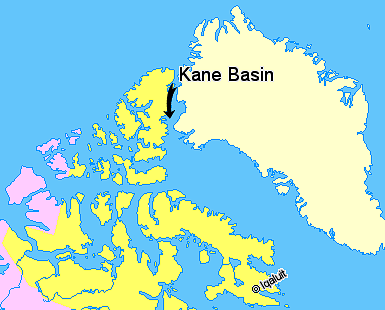
SEPTEMBER 25 2020 UPDATE
SEPTEMBER 2020 PAPER FINDS NO IMPACT OF CLIMATE CHANGE ON THE POLAR BEAR SUBPOPULATION IN THE KANE BASIN AND ATTRIBUTES THAT TO DIFFERENT SEASONAL SEA ICE DYNAMICS IN THAT REGION AND CLOSES WITH THE UNSUPPORTED SPECULATION THAT CLIMATE CHANGE WILL CATCH UP WITH THEM EVENTUALLY AS IT IS ONLY A MATTER OF TIME AND ONLY A MATTER OF HIGHER TEMPERATURES DRIVING LOWER SUMMER SEA ICE EXTENT.
CITATION: Transient benefits of climate change for a high‐Arctic polar bear subpopulation. Kristin L. et al: 23 September 2020 https://doi.org/10.1111/gcb.15286:
ABSTRACT: KANE BASIN is one of the world’s most northerly polar bear subpopulations, where bears have historically inhabited a mix of thick multiyear and annual sea ice year‐round. Currently, KANE BASIN is transitioning to a seasonally ice‐free region because of climate change. This ecological shift has been hypothesized to benefit polar bears in the near‐term due to thinner ice with increased biological production, although this has not been demonstrated empirically. We assess sea‐ice changes in KANE BASIN together with changes in polar bear 1. movements, 2. seasonal ranges, 3. body condition, and 4. reproductive metrics obtained from capture–recapture and satellite telemetry studies during two study periods (1993–1997 and 2012–2016). The annual cycle of sea‐ice habitat in KANE BASIN shifted from a year‐round ice platform (~50% coverage in summer) in the 1990s to nearly complete melt‐out in summer (<5% coverage) in the 2010s. The mean duration between sea‐ice retreat and advance increased from 109 to 160 days (p = .004). Between the 1990s and 2010s, adult female (AF) seasonal ranges more than doubled in spring and summer and were significantly larger in all months. Body condition scores improved for all ages and both sexes. Mean litter sizes of cubs‐of‐the‐year (C0s) and yearlings (C1s), and the number of C1s per AF, did not change between decades. The date of spring sea‐ice retreat in the previous year was positively correlated with C1 litter size, suggesting smaller litters following years with earlier sea‐ice breakup. Our study provides evidence for range expansion, improved body condition, and stable reproductive performance in the polar bear subpopulation. These changes, together with a likely increasing subpopulation abundance, may reflect the shift from thick, multiyear ice to thinner, seasonal ice with higher biological productivity. The duration of these benefits is unknown because, under unmitigated climate change, continued sea‐ice loss is expected to eventually have negative demographic and ecological effects on all polar bears.
CRITICAL COMMENTARY: The Kane Basin represents 0.03% of maximum Arctic sea ice area in April and 0.3% of minimum Arctic sea ice area in September. Sea ice and polar bear dynamics in a small sub-region over brief decadal time scales do not contain useful information about the impact of climate change on sea ice extent and polar bears. As noted above, no evidence is found in the data at longer time scales and larger geographical extents that sea ice extent is responsive to AGW or that it can be attenuated by reducing fossil fuel emissions.
In a related post we highlight geological features of the Arctic that play a significant role in Arctic sea ice dynamics and underscore the need for larger geographical extents and longer time scales for the assessment of the impact of climate change on September minimum Arctic sea ice extent and of its effects on the biota: [LINK]



MORE ABOUT ARCTIC POLAR BEARS FROM SEAWORLD.ORG

- LONGEVITY: Generally 20 to 30 years but as low as 15 and as high as 32. You can tell how old it is by looking at a thin slice of tooth and counting the layers.
- PREDATION: Adult polar bears have no predators except other polar bears but cubs less than one year old sometimes are prey to wolves and other carnivores and newborns may be eaten by the polar bears themselves especially if the mother is starved.
- INTRA-SPECIES PREDATION: This does not happen a lot but males fight over females and will kill the competition to get the lady he wants. In extreme hunger conditions, male polar bears may attack, kill, and eat female polar bears. This is not a normal behavior pattern but it does happen.
- HUMAN PREDATION: Humans have hunted, killed, and eaten Polar bears for thousands of years. Arctic people have traditionally hunted polar bears for food, clothing, bedding, and religious purposes. More recently commercial hunting for polar bear hides got started more than 500 years ago. There was a sharp rise in the kill rate in the 1950s when modern equipment such as snowmobiles, speedboats, and aircraft were employed in the polar bear hide trade. The hunt expanded to what was eventually viewed as a threat to the survival of the species and an International Agreement was signed in 1973 to ban the use of aircraft and speed boats in polar bear hunts although hunting continued to the extent that they were still the leading cause of polar bear mortality.
- THE CURRENT STATE OF HUMAN PREDATION: Today, polar bears are hunted by native arctic populations for food, clothing, handicrafts, and sale of skins. Polar bears are also killed in defense of people or property. However, hunting is strictly regulated in Canada, Greenland, Norway, and Russia. In Norway and Russia hunting polar bears is banned.
- CLIMATE CHANGE IMPACT: Increasing temperatures are associated with a decrease in sea ice both in terms of how much sea ice there is and how many months a year they are there. Polar bears use sea ice as a platform to prey mainly on ringed and bearded seals. Therefore, a decline in sea ice extent reduces the polar bear’s ability to hunt for seals and can cause bears to starve or at least to be malnourished.
- YOUNG POLAR BEARS: Subadults are inexperienced hunters, and often are chased from kills by larger adults. OLDER, WEAKER bears also are susceptible to starvation for the same reason – that they can’t compete with younger and stronger bears. So in hunt constrained situations, as in limited availability of sea ice, kids and seniors starve first.
- Climate change scientists have found (see bibliography above) that polar bear populations have shown increasing evidence of food deprivation including an increase in the number of underweight or starving bears, smaller bears, fewer cubs, and cubs that don’t survive into adulthood partially because in food constrained situations cubs are more likely to be eaten by adult polar bears. This takes place in areas that are experiencing shorter hunting seasons with limited access to sea ice. These conditions limit the bears’ ability to hunt for seals.
- The implication for climate impact studies is that a comparison of polar bear counts across time at brief time scales, in and of itself, may not have a climate change sea ice interpretation because of the number of variables involved in these dynamics.
July 21, 2020 at 5:59 pm
Reblogged this on uwerolandgross.
July 23, 2020 at 10:24 am
Updated.